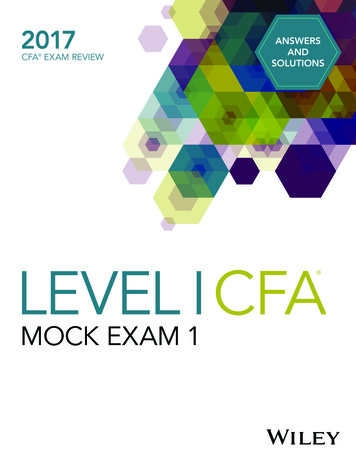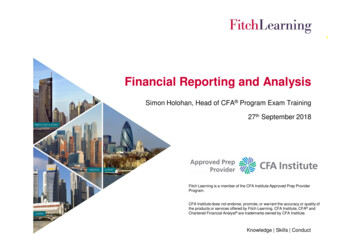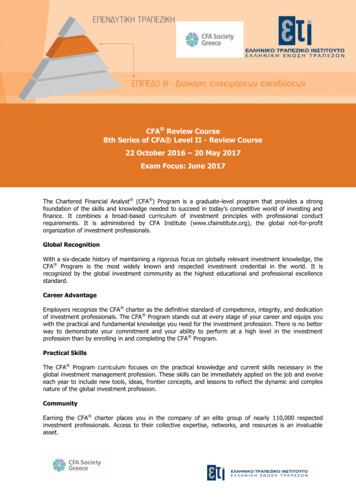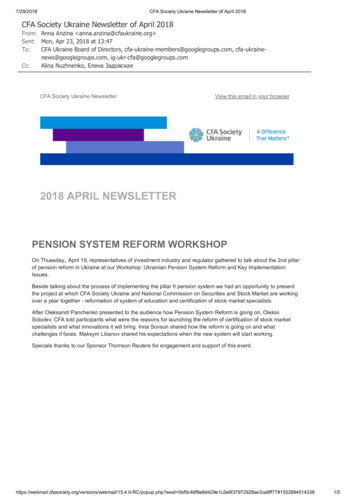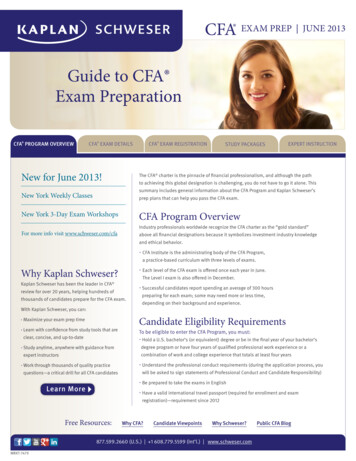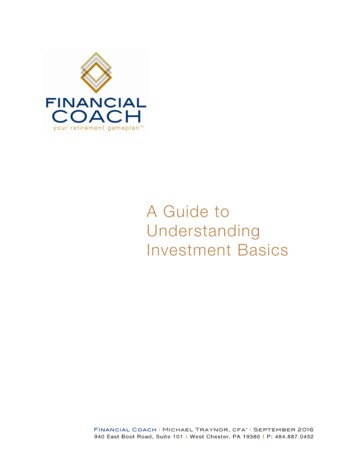
Transcription
Financial CoachMichael Traynor, cfa September 2016
Contents.“A GUIDE TO UNDERSTANDING INVESTMENT BASICS” 2016 FINANCIAL COACH2
“A GUIDE TO UNDERSTANDING INVESTMENT BASICS” 2016 FINANCIAL COACH3
Exh ib it 1Capital Markets Over The Long TermSource: Ibbotson SBBI “Stocks, Bonds, Bills and Inflation 1926-2014” – Morningstar (2015)1 Investing involves risk including loss of principal. No strategy assures success or protects against loss.“A GUIDE TO UNDERSTANDING INVESTMENT BASICS” 2016 FINANCIAL COACH4
Exh ib it 2S&P 500 Historical Drawdowns: 1927-2016Source: “180 Years of Market Drawdowns” – Ben Carlson, A Wealth of Common Sense (2016)“A GUIDE TO UNDERSTANDING INVESTMENT BASICS” 2016 FINANCIAL COACH5
Exh ib it 3Determinants of Investment PerformanceSource: “Determinants of Portfolio Performance” – Brinson, Hood, and Beebower (1986)2Asset Allocation does not ensure a profit or protect against a loss.“A GUIDE TO UNDERSTANDING INVESTMENT BASICS” 2016 FINANCIAL COACH6
Exh ib it 4The Efficient Market FrontierSource: Ibbotson Associates, Inc. – Morningstar3Past performance is no guarantee of future results. Risk and return are measured by standard deviation and arithmetic mean,respectively. This is for illustrative purposes only and is not indicati ve of any investment. Standard deviation is a historical measure ofthe variability of returns relative to the average annual return. If a portfolio has a high standard deviation, its returns h ave beenvolatile. A low standard deviation indicates returns h ave been less volatile.“A GUIDE TO UNDERSTANDING INVESTMENT BASICS” 2016 FINANCIAL COACH7
433% of revenues for S&P 500 companies were derived outside of the U.S. in 2014, according to Goldman Sachs Global InvestmentResearch.5There is no guarantee that a diversified portfolio will enhance overall returns or outperfor m a non-diversified portfolio. Diversificationdoes not protect against market risk. International investing involves special risks such as currency fluctuation and politic al instabilityand may not be suitable for all investors. These risks are often heig htened for investments in emerging markets.“A GUIDE TO UNDERSTANDING INVESTMENT BASICS” 2016 FINANCIAL COACH8
Exh ib it 5Top 25 Global CompaniesSource: Fortune 500 Global list of the world’s largest companies measured by revenue (2015)“A GUIDE TO UNDERSTANDING INVESTMENT BASICS” 2016 FINANCIAL COACH9
Exh ib it 6Asset Class Returns6Source: “Asset Class Returns” – Novel Investor (2016)Asset Class IndexiLarge Cap Stocks – S&P 500 IndexSmall Cap Stocks – Russell 2000 IndexInternational Stocks – MSCI EAFE IndexEmerging Market Stocks – MSCI Emerging Markets IndexREITS – FTSE NAREIT All Equity IndexHigh Grade Bonds – Barclays US Aggregate Bond IndexHigh Yield Bonds – BofAML US High Yield Master II IndexCash – 3 Month Treasury Bill Rate7AA – Asset Allocation Portfolio6Returns represent total annual returns with all distributions being reinvested and does not include fees and expenses. Data a s of12/31/2015.7Asset Allocation Portfolio is made up of 15% Large Cap Stocks, 15 % International Stocks, 10% Small Cap Stocks, 10% Emerging MarketStocks, 10% REITs, 40% High Grade Bonds, and annual rebalancing.“A GUIDE TO UNDERSTANDING INVESTMENT BASICS” 2016 FINANCIAL COACH10
Exh ib it 7Markets Have Rewarded DisciplineSource: MSCI World Index, 1970-2013“A GUIDE TO UNDERSTANDING INVESTMENT BASICS” 2016 FINANCIAL COACH11
Exh ib it 8Risk of Stock Market Loss Over Time8Source: Betterment8This chart is for illustrative purposes only and not indicative of any investment. An investment cannot be made directly in to an index.Index returns do not reflect taxes, transaction costs, investment advisory and other fees and expenses that would reduce perf ormance inan actual portfolio. Past performance is no guarantee of future results. Stocks in this example are represe nted by the Standard & Poor’s500, which is an unmanaged group of securities and is considered to be representative of the stock market in general. The dat a assumesreinvestment of all income but does not reflect taxes, investment advisory fees and other f ees and expenses that would reduceperformance in an actual portfolio.“A GUIDE TO UNDERSTANDING INVESTMENT BASICS” 2016 FINANCIAL COACH12
9Rebalancing a portfolio may cause investors to incur tax liabilities and/or transaction costs and does not assure a profit or protectagainst loss.“A GUIDE TO UNDERSTANDING INVESTMENT BASICS” 2016 FINANCIAL COACH13
Exh ib it 9All-In Investment Expenses for Retirement Plan Investors10Source: Bogle, Financial Analysts Journal, 2014 CFA Institute10Expense Ratio data source: Sharpe (2013); The 0.50% estimate for sales charges/fees is the midpoint of the range between 0% for DIYinvestors and 1% for investors who pay sales loads and fees to brokers and registered investment advisers.11Index Advantage is the difference between Active ly Managed Funds and Index Funds displayed as a percentage.12Investing in mutual funds involves risk, including possible loss of principal. Investors should consider the investment objectives, risks,charges and expenses of the investment company careful ly before investing. The prospectus and, if available, the summary prospectuscontain this and other important information about the investment company. You can obtain a prospectus and summary prospectus fromyour financial representative. Read carefully b efore investing.“A GUIDE TO UNDERSTANDING INVESTMENT BASICS” 2016 FINANCIAL COACH14
Exh ib it 1 0Percentage of Active U.S. Equity Fund Managers Underperforming the IndexSource: S&P Active versus Passive Scorecard (2015)13All performance referenced is historical and is no guarantee of future results. All indicies are unmanaged and may not be inv ested intodirectly.“A GUIDE TO UNDERSTANDING INVESTMENT BASICS” 2016 FINANCIAL COACH15
Exh ib it 1 1Asset-Weighted and Average Total and Investor Returns:Trailing Through December 31, 2013Source: Morningstar (2014)14Investing in mutual funds involves risk, including possible loss of principal.“A GUIDE TO UNDERSTANDING INVESTMENT BASICS” 2016 FINANCIAL COACH16
“A GUIDE TO UNDERSTANDING INVESTMENT BASICS” 2016 FINANCIAL COACH17
iThe Standard & Poor’s 500 Index is a capitalization weighted index of 500 stocks designed to measure performance of the broaddomestic economy through changes in the aggregate market value of 500 stocks representing all major industries.The Russell 2000 Index is an unmanaged index generally representative of the 2,000 smallest companies in the Russell 3000 index, which representsapproximately 10% of the total market capitalization of the Russell 3000 Index.The MSCI EAFE Index is a free float-adjusted market capitalization index that is designed to measure the equity market performance of developedmarkets, excluding the US & Canada. The MSCI EAFE Index consists of the following developed country indices: Australi a, Austria, Belgium, Denmark,Finland, France, Germany, Hong Kong, Ireland, Israel, Italy, Japan, the Netherlands, New Zealand, Norway, Portugal, Singapore , Spain, Sweden,Switzerland and the UK.The MSCI EM (Emerging Markets) Index is a free float-adjusted market capitalization weighted index that is designed to measure the equity marketperformance of the emerging market countries of the Americas, Europe, the Middle East, Africa and Asia. The MSCI EM Index con sists of the followingemerging market country indices: Brazil, Chile, Colombia, Mexico, Peru, Czech Republic, Egypt, Greece, Hungary, Poland, Qatar, Russia, South Africa ,Turkey, United Arab Emirates, China, India, Indonesia, Korea, Malaysia, Philippines, Taiwan, and Thailand.The FTSE NAREIT All Equity REITs Index is a free-float adjusted, market capitalization-weighted index of U.S. Equity REITs. Constituents of the Indexinclude all tax-qualified REITs with more than 50 percent of total assets in qualifying real estate assets other than mortgages secured by real property.The Barclays U.S. Aggregate Bond Index is an index of the U.S. investment-grade fixed-rate bond market, including both government and corporatebonds.The Merrill Lynch US High Yield Master II Index (H0A0) is a commonly used benchmark index for high-yield corporate bonds. It is administered byMerrill Lynch. The Master II is a measure of the broad high yield market, unlike the Merrill Lynch BB/B Index, which excludes lower-rated securities.This material has been prepared by Fi nancial Coach for informational purposes only. This material is not, and should not be regarded asinvestment advice or as a recommendation regarding any particular security or course of action. A professional advisor should beconsulted before implementin g any of the options presented. No content should be constructed as legal or tax advice. Always consult anattorney or tax professional regarding your specific legal or tax situation.Investment Advice offered through FC Advisory LLC, a registered invest ment advisor doing business as Financial Coach. FinancialCoachGroup.comFINANCIAL COACH
12 Investing in mutual funds involves risk, including possible loss of principal. Investors should consider the investment objectives, risks, charges and expenses of the investment company carefully before investing. The prospectus and, if available, the summary prospectus contain this and

